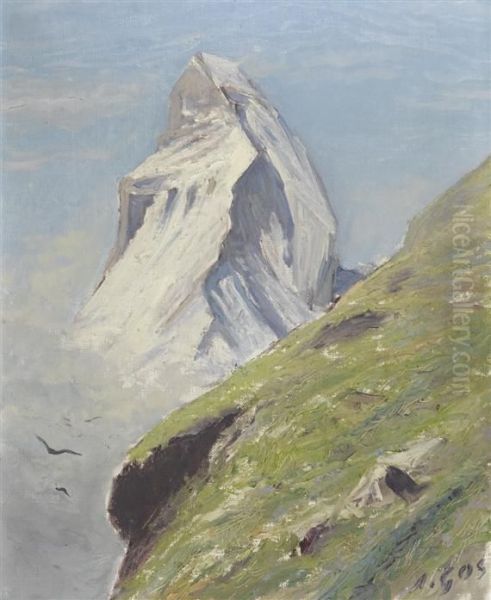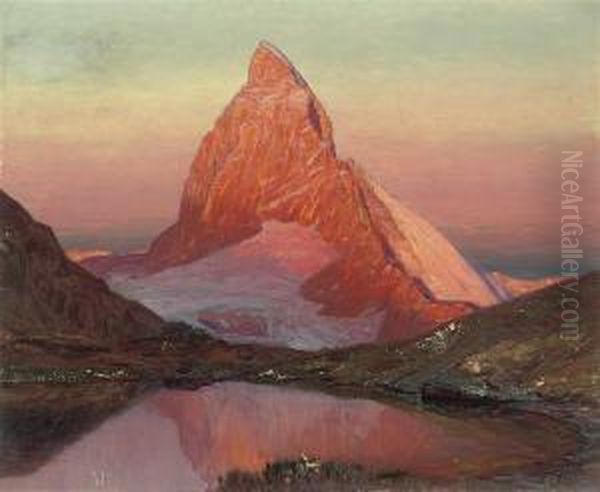Albert Henri John Gos stands as a significant, if sometimes overlooked, figure in the rich tradition of Swiss Alpine painting. Active during a period of profound artistic change and a burgeoning appreciation for the natural world, Gos dedicated much of his oeuvre to capturing the sublime beauty and formidable presence of the Swiss Alps, most notably the iconic Matterhorn. While detailed biographical accounts of his personal life and extensive exhibition records remain somewhat elusive in broader art historical narratives, his surviving works offer compelling testimony to his skill as an oil painter and his deep connection to the mountainous landscapes of his homeland.
The Artist in Context: Late 19th and Early 20th Century Landscape Painting
Born in 1852 and passing away in 1942, Albert Henri John Gos's life spanned a transformative era in European art. The latter half of the 19th century saw the legacy of Romanticism, with its emphasis on emotion and the grandeur of nature, gradually give way to Realism, which sought a more direct and unidealized depiction of the world. Artists like Gustave Courbet in France championed this move towards truth in representation. Concurrently, the revolutionary stirrings of Impressionism were beginning, with painters such as Claude Monet and Camille Pissarro exploring the fleeting effects of light and atmosphere, often en plein air.
In Switzerland, a strong tradition of landscape painting had already been established by artists like Alexandre Calame, whose dramatic Alpine scenes were internationally renowned in the mid-19th century. Calame's work, often imbued with a Romantic sensibility, set a high bar for subsequent generations of Swiss landscape artists. Another influential figure in Swiss art education was Barthélemy Menn, who taught at the Geneva School of Fine Arts and encouraged a more personal and sincere observation of nature, influencing a generation that included the celebrated Ferdinand Hodler. Gos would have matured as an artist within this evolving artistic milieu, where the depiction of the national landscape, particularly the Alps, held significant cultural and aesthetic value.
The Enduring Allure of the Alps

The Alps have long captivated the human imagination, serving as a source of inspiration, awe, and trepidation. For artists, they presented a unique set of challenges and rewards. The sheer scale, the dramatic interplay of light and shadow, the ever-changing atmospheric conditions, and the raw, untamed beauty of the high peaks demanded both technical skill and a profound emotional response. Early pioneers in depicting the Alps, such as the British master J.M.W. Turner, had already demonstrated the expressive potential of these landscapes, often infusing them with a sense of the sublime. The writings and artworks of John Ruskin, another influential Briton, further popularized Alpine scenery and advocated for a truthful, detailed rendering of nature.
By the time Gos was actively painting, mountaineering was also gaining popularity, bringing more people into direct contact with the high Alps and fostering a greater appreciation for their unique environment. Artists like Gabriel Loppé, a French painter and accomplished mountaineer, combined their passion for both pursuits, creating works that conveyed an intimate knowledge of the mountains. Gos, as a Swiss artist, was intrinsically linked to this Alpine world, and it became a central theme in his artistic output.
Albert Gos and the Iconic Matterhorn
Among Gos's most recognized subjects is the Matterhorn, one of the world's most distinctive and challenging peaks. His oil on canvas painting, simply titled The Matterhorn, measuring 61 x 50 cm and signed by the artist, exemplifies his engagement with this colossal natural monument. Another work, The Matterhorn at dusk, further highlights his fascination with the mountain under different lighting conditions, a common preoccupation for landscape painters seeking to capture the ephemeral moods of nature.
The Matterhorn had already achieved legendary status, not only for its dramatic pyramidal shape but also for the tragic first ascent led by Edward Whymper in 1865. Whymper himself was an accomplished illustrator, and his sketches and engravings helped to cement the Matterhorn's image in the public consciousness. Gos's depictions would have contributed to this ongoing artistic dialogue with the mountain, offering his own interpretation of its formidable presence and atmospheric envelope. His approach, judging by the general characteristics of Alpine painting from that era, likely involved careful observation of geological forms, a keen sensitivity to the effects of light, and an ability to convey the immense scale and grandeur of the peak.
Other Known Works and Stylistic Considerations

Beyond his celebrated Matterhorn scenes, another notable work by Albert Gos is Châtaigne (Chestnut). This oil on canvas, measuring 73 x 60 cm, was created in 1942, the year of his death. The painting is signed, and interestingly, bears the name "Clarence" on its reverse. While the subject matter—a still life, presumably featuring chestnuts—differs from his grand Alpine vistas, it suggests a versatility in his artistic practice. Still life painting offers a different set of artistic challenges, focusing on form, texture, and the interplay of light on a smaller, more intimate scale. It is possible that Châtaigne reflects a quieter, more contemplative aspect of his later work.
Gos consistently worked in oils, a medium favored for its richness, depth of color, and ability to render both fine detail and broad atmospheric effects. While specific analyses of his brushwork or color palette are scarce in widely available literature, his commitment to Alpine subjects suggests a style rooted in representational accuracy, likely informed by the Realist tendencies of the 19th century, yet potentially imbued with a personal, perhaps subtly Romantic or Post-Impressionistic, sensibility in his handling of light and atmosphere. The "painterly" feel, often associated with artists who emphasize the material qualities of paint and visible brushstrokes, might also be a characteristic, though further visual analysis of a broader range of his works would be needed to confirm this.
The Swiss Artistic Landscape During Gos's Career
Albert Gos practiced his art during a vibrant period for Swiss art. While he focused on Alpine landscapes, other Swiss artists were exploring different themes and styles. Ferdinand Hodler, arguably the most famous Swiss artist of the era, also painted mountains, but his approach evolved towards Symbolism and a distinctive style he termed "Parallelism," characterized by rhythmic compositions and monumental figures. Hodler's Alpine landscapes, such as The Eiger, Mönch and Jungfrau above a Sea of Fog, possess a symbolic power and stylization that differ from the more traditional representational approach often seen in Gos's generation.

Other contemporaries included Giovanni Giacometti (father of Alberto Giacometti), who became a leading figure in Swiss Post-Impressionism, known for his vibrant use of color and depictions of light in Alpine settings. Cuno Amiet, another prominent Swiss modernist, explored Fauvism and Expressionism, bringing bold colors and expressive forms to Swiss art. While Gos may not have directly engaged with these avant-garde movements in the same way, he was part of a national artistic community that was diverse and dynamic. His dedication to the more traditional genre of Alpine landscape painting provided a counterpoint to these modernist explorations, upholding a legacy of careful observation and reverence for the natural world. The works of artists like Ernest Biéler, who often depicted rural life and landscapes with a decorative, Art Nouveau-influenced style, also formed part of this rich tapestry.
Navigating an Artist's Legacy: Exhibitions and Collaborations
The available information, as collated from various sources, does not provide specific details about Albert H. Gos's participation in major art movements, significant solo or group exhibitions, or collaborations with other named painters of his time. This is not uncommon for artists who, while accomplished and recognized within their sphere, may not have achieved the same level of international fame or comprehensive archival documentation as some of their more revolutionary contemporaries.
The art world of the late 19th and early 20th centuries was vast, with numerous regional schools, artistic societies, and exhibition venues. It is highly probable that Gos exhibited his works, perhaps in Geneva, Zurich, or other Swiss cultural centers, and potentially in neighboring countries where Alpine art was appreciated, such as France or Germany. However, without specific records, such participation remains speculative. His connection to any particular artistic group or formal association is also not clearly documented. This lack of detailed information does not diminish the intrinsic value of his work but rather highlights the challenges art historians sometimes face in reconstructing the complete careers of artists who fall outside the most prominently documented canons. His legacy, therefore, rests primarily on the visual evidence of his paintings themselves.
The Enduring Appeal of Albert Gos's Vision
Albert Henri John Gos's paintings, particularly his depictions of the Matterhorn, continue to find an audience, often appearing in art auctions where they are appreciated for their skillful execution and evocative portrayal of Alpine scenery. His work contributes to a long and distinguished lineage of artists who have sought to capture the unique character of the Swiss Alps. These paintings serve not only as aesthetic objects but also as historical documents, reflecting a particular way of seeing and valuing the natural world that was prevalent during his lifetime.
His dedication to oil painting and his focus on landscape connect him to a broad tradition that includes not only his Swiss predecessors like Calame but also international figures who celebrated the grandeur of nature, from the Romantic landscapes of Germany's Caspar David Friedrich to the expansive canvases of the American Hudson River School painters like Albert Bierstadt, who, though depicting a different continent's mountains, shared a similar awe for untamed wilderness. Even the Barbizon School painters in France, such as Théodore Rousseau, with their commitment to direct observation of nature, share a common philosophical thread with artists like Gos.
Conclusion: A Master of Mountain Scenery
Albert Henri John Gos (1852-1942) was a dedicated Swiss artist whose life's work was significantly shaped by the majestic presence of the Alps. Through his oil paintings, he conveyed the formidable beauty, the changing light, and the enduring spirit of these iconic mountains, with the Matterhorn holding a special place in his oeuvre. Works like The Matterhorn, The Matterhorn at dusk, and the later Châtaigne reveal an artist proficient in his medium and deeply connected to his subjects.
While the full extent of his exhibition history and direct associations with contemporary artistic movements may require further specialized research, his contribution to the genre of Alpine painting is undeniable. He stands as a testament to the enduring power of landscape art to capture not just the physical appearance of a place, but also the profound emotional and cultural resonance it holds. In the grand narrative of art history, Albert Gos remains a valued voice, offering a window onto the sublime landscapes of Switzerland as seen through the eyes of a skilled and sensitive observer. His paintings continue to evoke the timeless allure of the Alps, securing his place among the notable chroniclers of mountain majesty.